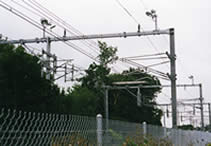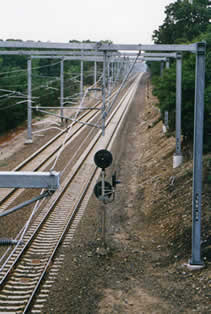America was built on the strength of two great transportation resources - rivers and railways. Of the two, the railroad has always held a special place in American folklore. Any mention of the Wild West never fails to raise the image of the great steam trains that crossed the prairies and mountains.
Today, railroads still play a critical role in the American economy. Although most of our country's rolling stock is dedicated to hauling freight, the railroads are making a remarkable comeback in the area of passenger travel.
One of the more ambitious rail projects in recent years is the development of a high speed rail corridor between Boston, Massachusetts, and Washington, DC. The new service from Amtrak is called "Acela" - a combination of the words "acceleration" and "excellence." The new trains travel at speeds of up to 150 miles per hour (250 km/hr), substantially reducing travel time between the key East Coast cities of Boston, New York, Philadelphia, Baltimore and Washington.
Prior to the initiation of the Acela train service, major renovations and upgrades were made to track and roadbeds all along the route. Tracks that carried diesel powered trains were electrified to accommodate the new Acela trains.
The most challenging section of the track electrification project was the Northend Electrification Project, the stretch between Boston and New York City. Alternately traveling through heavily urbanized areas and scenic coastal stretches, more than 200 miles of track were converted between Boston and New Haven, Connecticut (where previously electrified track begins).
This challenging project was constructed by Balfour Beatty/MEC, a joint venture of Balfour Beatty Construction and Massachusetts Electric Construction Company. Balfour Beatty was primarily responsible for engineering, while MEC is handling purchasing and construction duties.
To carry the high voltage electrical wire required to power the Acela trains between Boston and New Haven, Balfour Beatty/MEC erected a series of 30-foot high galvanized steel poles, set on precast concrete foundations. A set of two poles was erected every 200 feet for the entire length of the track.
On each of these vertical poles, a two-inch galvanized pole is cantilevered out to hold the suspended electrified conductor wire. In addition, four new electrical substations were built.
As you can imagine, the requirement for galvanized steel on the project was enormous. The galvanizing was specified at 3.9 mils zinc, per ASTM A123 and A153.
There are numerous welds, fittings and bolted connections on each pole assembly, most of which required remediation work due to surface rust, cutting, grinding and CAD welds for grounding purposes. This extensive finishing work (along with field repair of damaged galvanizing) called for a powerful rust prevention coating.
After extensive testing, Balfour Beatty/MEC selected ZRC Cold Galvanizing Compound to do the job (See "Close...").
Now you can board Amtrak's sleek, new Acela train at Boston's South Station and travel swiftly along the rails to New Haven, New York and beyond in comfort and style. The ride is all that much more enjoyable with the knowledge that ZRC has done its part to make the way safer and more secure.



